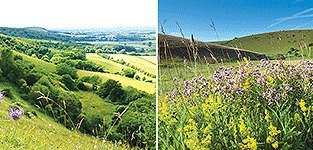Glow Worms: Glow-worms: Lampyris noctiluca
June 2nd, 2019 The Glow-worm is a medium-sized, narrow beetle. The males look like typical beetles, but the females have no wings and look similar to the larvae.
The Glow-worm is a medium-sized, narrow beetle. The males look like typical beetles, but the females have no wings and look similar to the larvae.Species information Category: Beetles. Statistics: Length: 1.5 - 2.5cm.
Conservation status: Common. When to see: June to July.
About:
The Glow-worm is a medium-sized, narrow beetle. The males look like typical beetles, but the females have no wings and look similar to the larvae. Glow-worms are most often found as larvae, living under rocks on chalk or limestone grassland, and feeding on slugs and snails. Gardens, hedgerows, railway embankments, woodland rides, heath lands and cliffs are all possible habitats for Glow-worms. Females are famous for emitting a greenish/orange light from their bottoms at night. They climb up plant stems and glow in order to attract males, who have large, photosensitive eyes - perfect for scanning vegetation at night. The larvae can also emit light, and so can the eggs. Adults are only around for a short period in June and July.
How to identify:
The male Glow-worm is a light brown, typical beetle. The larva is greyish-brown with yellowish/orange triangular markings at the side of each segment. The female is similar in appearance to the larva, but is unmistakable when she lights up at night.
Distribution:
Found in parts of England (particularly the South), lowland Scotland, and Wales.
Habitats:
Grassland - Heath land and Moorland - Farmland - Coastal - Woodland.
Did you know?
The larvae of Glow-worms are predators, feeding on slugs and snails. They kill their prey by delivering a series of toxic bites, injecting digestive proteins that paralyse and eventually dissolve the soft body of the slug or snail. While the Glow-worm is waiting for this process to happen, it might ride on the snail’s back, keeping away from the sticky mucus it produces.
How people can help:
The Wildlife Trusts manage many grassland habitats sympathetically for the benefit of all kinds of wildlife. Careful grazing with traditional breeds, hay-cutting at the right time and scrub clearance are just some of the ways grasslands are kept in good condition. By volunteering for your local Trust you can help too, and you’ll make new friends and learn new skills along the way.
Credit: Wildlife Trusts - sussexwildlifetrust.org.uk
Conservation status: Common. When to see: June to July.
About:
The Glow-worm is a medium-sized, narrow beetle. The males look like typical beetles, but the females have no wings and look similar to the larvae. Glow-worms are most often found as larvae, living under rocks on chalk or limestone grassland, and feeding on slugs and snails. Gardens, hedgerows, railway embankments, woodland rides, heath lands and cliffs are all possible habitats for Glow-worms. Females are famous for emitting a greenish/orange light from their bottoms at night. They climb up plant stems and glow in order to attract males, who have large, photosensitive eyes - perfect for scanning vegetation at night. The larvae can also emit light, and so can the eggs. Adults are only around for a short period in June and July.
How to identify:
The male Glow-worm is a light brown, typical beetle. The larva is greyish-brown with yellowish/orange triangular markings at the side of each segment. The female is similar in appearance to the larva, but is unmistakable when she lights up at night.
Distribution:
Found in parts of England (particularly the South), lowland Scotland, and Wales.
Habitats:
Grassland - Heath land and Moorland - Farmland - Coastal - Woodland.
Did you know?
The larvae of Glow-worms are predators, feeding on slugs and snails. They kill their prey by delivering a series of toxic bites, injecting digestive proteins that paralyse and eventually dissolve the soft body of the slug or snail. While the Glow-worm is waiting for this process to happen, it might ride on the snail’s back, keeping away from the sticky mucus it produces.
How people can help:
The Wildlife Trusts manage many grassland habitats sympathetically for the benefit of all kinds of wildlife. Careful grazing with traditional breeds, hay-cutting at the right time and scrub clearance are just some of the ways grasslands are kept in good condition. By volunteering for your local Trust you can help too, and you’ll make new friends and learn new skills along the way.
Credit: Wildlife Trusts - sussexwildlifetrust.org.uk
Comments (0)
No comments have been submitted yet.Why not be the first to send us your thoughts
Leave A Comment
Thank you for your comments, they will appear shortly once approved.
Recent Posts
Have You Seen...






